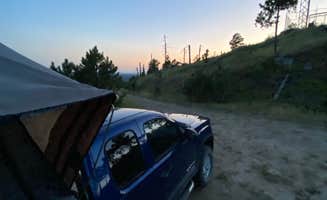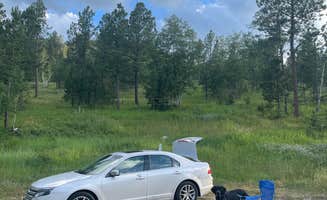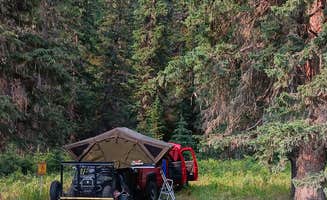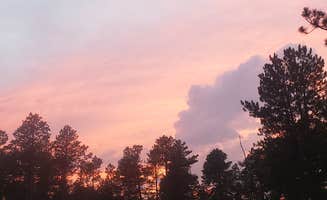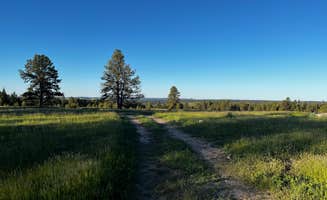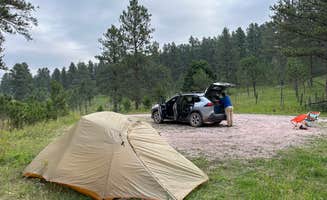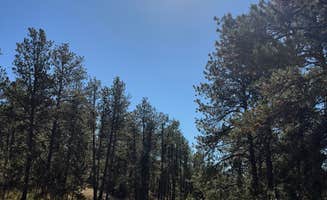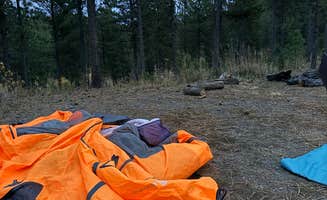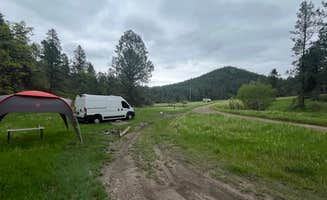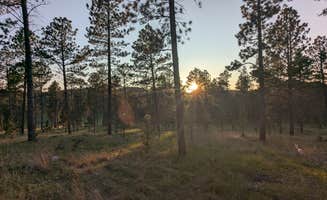Dispersed camping areas near Custer, South Dakota typically follow standard Black Hills National Forest regulations requiring campers to set up at least 100 feet from water sources and 300 feet from developed recreation areas. These primitive sites sit within pine forests at elevations between 4,000-7,000 feet where summer daytime temperatures average 75-85°F but drop significantly at night. Weather conditions can shift rapidly throughout the day, with afternoon thunderstorms common in summer months.
What to do
Hike Black Elk Peak from Needles Highway: Needles Highway Dispersed Site provides excellent access to the highest point in South Dakota. "This spot is perfect for anyone looking to spend time at Sylvan Lake or hike Black Elk Peak. We are about 10 minutes from all of that!" notes Nicholas S.
Explore Wind Cave National Park: Camp at Cold Springs School Road by Beaver Creek for easy access to this underground wonder. "About 2 miles from the wind cave entrance," reports Nicole L., making it convenient for early morning tours before crowds arrive.
Wildlife viewing in meadows: Many forest service roads provide access to open clearings where wildlife gathers. "I was inspired to compose poetry overlooking a meadow with deer feeding in the morning," writes Chris N. about Spring Creek Road. Dawn and dusk offer the best viewing opportunities when animals are most active.
What campers like
Privacy between sites: North Pole Rd Dispersed Camping offers well-spaced campsites. "There are other people but far enough away that you don't feel crowded," explains Ashley A. This spacing provides a sense of solitude while maintaining the security of having others nearby.
Natural soundscapes: Many campers appreciate the ambient sounds at rustic camping sites near Custer. "We got to listen to some coyotes in the distance," Ashley A. adds about North Pole Road, highlighting the wilderness experience these primitive sites provide.
Accessibility for various vehicles: RD 356 Dispersed Site accommodates different vehicle types. "The road is well maintained and easy to get down. I saw some larger RVs at the sites closer to the entrance," reports Tyler M., though he cautions about venturing too far in larger vehicles.
What you should know
Seasonal conditions affect access: Forest roads can become challenging after rain or snow. "If it has recently rained I can see it being pretty difficult," warns Jacob V. about Calumet Rd Dispersed Camping, while Michael M. advises "Definitely advise 4x4 if it's been wet at all" for RD 356.
Campsite availability fluctuates: During peak summer season, arriving early is essential. "We came in one afternoon and there was hardly any sites available," reports Chloe T. about North Pole Rd, while Josh Z. notes "All the other spots down the road were taken so we pulled into a field across from the private road."
Cellular coverage varies by location: Service is inconsistent throughout the Black Hills. "Cell coverage is poor but still present," notes Jérémy D. about North Pole Road, while Jacob V. reports "T-Mobile service was basically non-existent" at Calumet Road.
Fire restrictions change throughout the season: Many areas prohibit campfires during dry periods. "There were signs that no campfires are allowed in the area," reports Truly W., making it important to check current restrictions before setting up camp.
Tips for camping with families
Choose sites with exploration opportunities: Dispersed Camping near Calumet Road offers natural features for children to explore. "The undulating terrain makes for great day hikes and exploration," notes Wayne L., providing entertainment without electronic devices.
Consider bug protection: Insects vary by season and location. "Tons of mosquitoes! Glad we had a screen on our EzUp. Bring lots of deet," warns Elizabeth R. about Calumet Road, while others report fewer insects at higher elevations.
Plan for temperature swings: Black Hills elevations cause significant day-to-night temperature changes. "Weather was great, very mild. Air was fresh and crisp," reports Connor M. from RD 356, but many campers recommend packing warm clothing even in summer.
Keep a wildlife journal: Many sites offer excellent animal viewing opportunities. "Saw many deer near sunset," notes Makenzie S. at Cold Springs School Road, making wildlife spotting a fun educational activity for children.
Tips from RVers
Scout before committing: Forest service roads vary in quality and accessibility. "I would suggest scouting them first before dragging a trailer down them," advises Ryan P. about Calumet Road Dispersed Camping, while another camper notes "High clearance required after the first 3 sites" at RD 356.
Consider smaller trailers: Many dispersed sites accommodate modest rigs but challenge larger ones. "The spot is large and easily accommodates our truck and 35' travel trailer," reports Nicholas S. about Needles Highway, but most sites favor more compact setups.
Look for level spots: Natural terrain often lacks grading. "Pretty level and had a fireplace," notes Allison D. about North Pole Road, while Michael U. mentions "The location by the road has a pull-through and could fit a decent size camper" at Needles Highway.
Solar capabilities: Forest cover affects solar panel effectiveness. "The trees are spread out enough for solar/starlink," notes Kelda C. about North Pole Road, an important consideration for those relying on solar power for extended stays in primitive camping areas near Custer.


